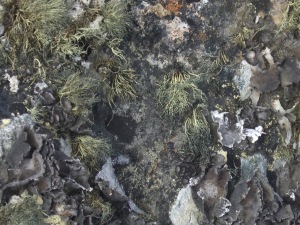
What a treat, but not nearly as exciting as a stroll on Snow Island packed with comical and enormous elephant seals and many Weddell seals and cubs. Elephant seals look like grounded torpedoes, huge ones from submarine days. In one zone a dozen males were lined side by side much like football linebackers, but bigger. It made you laugh when they raised their fat necks or opened huge mouths to emit gurgling, burping and gaseous sounds.
Since most of them had probably not encountered often vertical mammals in red jackets and red hats with cameras for eyes, they were curious but were not going to be bothered sufficiently to move somewhere else. These guys were belly to belly, so to speak, in order to keep warm in the shore winds and also it helped wrap up their fur molting which was in its final stages.
We stay 15 feet away from them in an effort to not interrupt their daily routines but there were so many, 15 feet from one was close to the next outlying one. When they traveled, dragging their enormous poundage, it looked painful. Only the younger seals moved with any speed or energy.
As I was photographing a huge elephant seal lumped on the snow, a chin-strap penguin appeared (this was not penguin territory) and walked right up to about three feet in front of me (as I stood stone still) and began flapping his wings, pecking his tail to get the oil he spreads on his waterproof body, and generally cleaning himself. Miracle Island, this.
After trapsing along the ice-packed island shores among the hundreds of scattered seals on snow, a couple of us stumbled across a deep hole in the snow field, about 16 inches wide, and inside was a young Weddell seal, obviously trapped. We had no solution, only wondered if she was in there by choice or by accident. What could we do? But then I walked further on and came upon an even larger hole in the ice in which had fallen two seal pups. One tiny who we’ll call Tinkerbell and the other Megita.
Megita had dreamy big black eyes which looked right at me with pain and desperation. I took a few photographs (I was right on top of her) and asked the naturalist Stefan what could we do. I insisted we had to dig her out or she and the pup would die. “Look how she pleads to me with her big eyes!” On the one hand, one doesn’t want to bother the natural course of things, but on the other hand, who could sleep knowing they had passed this opportunity to rescue young seals who had a future as producers.
I asked if anyone on the Zodiacs had a shovel, and one was found. Meanwhile Stefan started trying to widen the hole by kicking with his boot, and a couple others helped until the shovel arrived. I chronicled the rescue with my camera and trying to reassure Megita she could lift herself out, we’d help, as if she really understood what I was saying. Maybe she did. As they opened up a sort of snow ramp up which she might pull herself, she showed great force and eagerness to get up and out. I stood right in front of her and kept talking her out of the hole.
Stefan finally had the snow slide where it might be useful to her, and then jumped in undaunted by any thought of danger – they only nip at this age, not take bites, he assured us – and tried to shove hundreds of pounds of pure blubber up the little snow exit. It was a herculean task, like birthing a baby, but with help from the seal herself, I know she was trying, we got her out. She came straight for my boot. I moved back a bit. She followed me. And again and again she moved and put her nose on my boot. I wanted so much to reach down and touch her head but I knew if I did that I wouldn’t be able to leave that island again. There was something special in her eyes.
Meanwhile three of the men lifted Tinkerbell out of the hole and the two seals barked and talked and kissed each other and seemed as if they knew their lives had been saved. Amazing.
As the three men finished filling the hole with ice, I grabbed the shovel and we all went to look for the other hole with the more desperate seal locked in it. This was a serious situation because it was a mature seal, we’ll call her Maria, and her large fat body was frozen into the ice of parts of the hole. Her flipper was damaged as well. When we began knocking in the snow and trying to widen the hole to 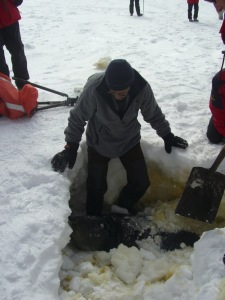 make an exit, she began nipping at Stefan and yelling at us out of fear. But Stefan and crew persevered and more and more of the red-coated photographers gathered around to be sure they had it on their digitals. Few actually got down and dirty as did Stefan and Scott, the travel writer. The ice they dug into with shovel and hand was yellowed with urine and poop. She had been there a while and could have stayed a long time with all the fat on her dying a slow death.
make an exit, she began nipping at Stefan and yelling at us out of fear. But Stefan and crew persevered and more and more of the red-coated photographers gathered around to be sure they had it on their digitals. Few actually got down and dirty as did Stefan and Scott, the travel writer. The ice they dug into with shovel and hand was yellowed with urine and poop. She had been there a while and could have stayed a long time with all the fat on her dying a slow death.
Her spirit wasn’t half as hopeful as Megitas so this task was harder. We had to dig out a huge amount of the snow and release her flippers th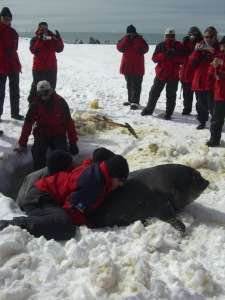 at were frozen under her belly. So finally she was turned toward the escape hatch and Stephan again, with two more men, jumped in and gave Maria numerous shoves and lifts until she finally was set free. She barked and grumbled and just lay there. Not sure what we were and the photographers were more interested in getting their pictures than opening a path for Maria to move on to where she felt at home. She was probably still in some sort of shock.
at were frozen under her belly. So finally she was turned toward the escape hatch and Stephan again, with two more men, jumped in and gave Maria numerous shoves and lifts until she finally was set free. She barked and grumbled and just lay there. Not sure what we were and the photographers were more interested in getting their pictures than opening a path for Maria to move on to where she felt at home. She was probably still in some sort of shock.
Whether we have done any good this morning on Snow Island in Antarctica, I don’t know. But Stefan and I and the others involved with the rescue certainly will be able to sleep better tonight knowing three young seals had futures. This expedition has been an adventure in rescues and working with heroes, like Stefan. I knew something special happened to me today and I could only think of my dear friend Louise who has been communing with bears, elk, geese and any other animal that comes through her yard in Wyoming for nine years. Lou, this one was for you.

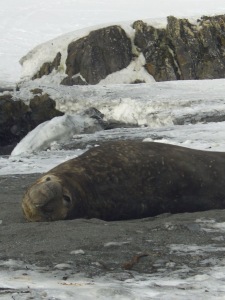
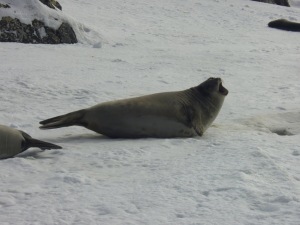
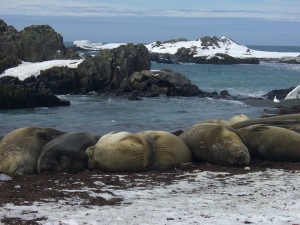

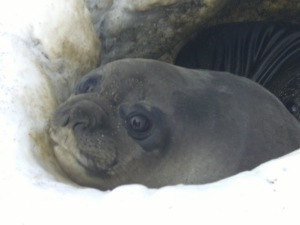
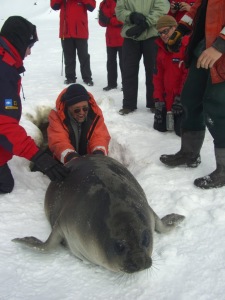
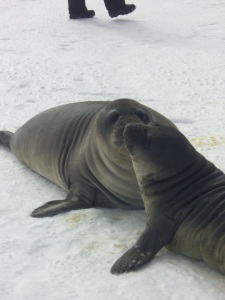
THANK YOU FOR SAVING THE SEALS!
what was it like to be ther? was it cold? love your granddaughter,MM xoxoxo